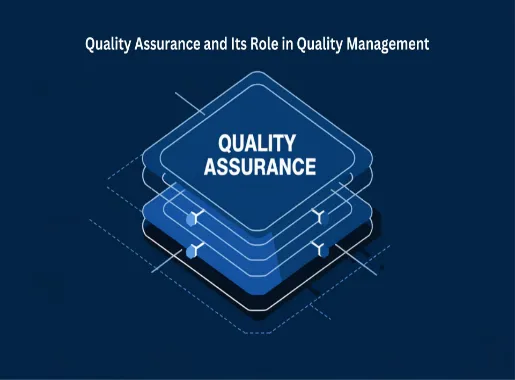Quality Assurance Performance Improvement
Today customers demand more and expectations are higher than ever, ensuring your product or service meets the mark isn’t just important—it’s essential. From software companies to healthcare providers, businesses across all industries are constantly striving to deliver quality in everything they do. But how do they make sure they’re not just meeting standards, but actually improving along the way?

This is where Quality Assurance (QA) and Performance Improvement (PI) come in. While QA focuses on ensuring that products and services meet specific quality standards, PI is about refining processes and systems to make everything more efficient, effective, and customer-centric. Together, they create a powerful approach to problem-solving and continuous growth.
In this blog, we will explore the critical role that QA and PI play in business operations, how they interconnect, and how organizations can harness their potential to achieve sustained growth and continuous improvement.
What is Quality Assurance Performance Improvement?
Quality Assurance Performance Improvement refers to the ongoing efforts and strategies implemented to enhance the effectiveness, efficiency, and overall performance of an organization’s quality assurance (QA) processes. The goal of QA performance improvement is to ensure that products or services meet or exceed defined quality standards while minimizing defects, reducing costs, and improving customer satisfaction.
Quality assurance is essential in identifying and addressing issues before they reach the customer or end-user. Performance improvement within QA involves refining testing methods, optimizing workflows, and utilizing tools and technologies to ensure that QA processes deliver better results faster, with higher accuracy and consistency.
When combined, QA and PI form QAPI (Quality Assurance and Performance Improvement)—a comprehensive, data-driven, and proactive approach aimed at:
- Identifying areas with potential for improvement
- Addressing gaps or inefficiencies within systems and processes
- Developing and implementing corrective action plans
- Continuously monitoring the effectiveness of improvement interventions
Key Aspects of Quality Assurance Performance Improvement
Improving quality assurance performance involves several strategic areas of focus. By addressing these key aspects, organizations can enhance the effectiveness of their QA processes, optimize workflows, and ensure better overall quality. Here are the most important aspects to consider when working towards QA performance improvement:

1. Process Optimization:
- Streamlining QA workflows to eliminate inefficiencies, reduce redundancies, and speed up testing cycles.
- Integrating automation into repetitive testing tasks to improve speed and accuracy.
2. Defect Prevention:
- Identifying the root causes of defects or errors early in the development process, thereby preventing them from escalating into larger problems.
- Using techniques like root cause analysis and continuous testing to prevent recurrence of issues.
3. Training and Skill Development:
- Continuous training of QA teams to keep them updated on the latest tools, technologies, and best practices.
- Encouraging knowledge sharing and cross-functional collaboration to improve team skills and performance.
4. Data-Driven Decision Making:
- Tracking and analyzing key performance indicators (KPIs) related to QA, such as defect rates, test coverage, and resolution times.
- Using this data to drive decisions, identify areas of improvement, and adjust QA strategies accordingly.
5. Adopting Agile and DevOps Practices:
- Incorporating agile methodologies, like Scrum or Kanban, to create iterative testing cycles and foster continuous improvement.
- Integrating QA into the DevOps pipeline to enable continuous integration and continuous testing (CI/CD), improving speed and quality.
6. Feedback Loops:
- Implementing regular feedback loops from internal teams, customers, and stakeholders to continually refine QA practices.
- Encouraging collaboration between development, QA, and other departments to align on quality goals and resolve issues quickly.
7. Enhanced Test Coverage:
- Increasing test coverage ensures that a larger portion of the product or system is being tested for quality. This includes functional, non-functional, and edge case testing.
- Expanding test scenarios to include both typical and extreme use cases helps identify potential issues early.
8. Test Environment Management:
- Properly managing test environments ensures that they closely mirror production environments, which can help identify environment-specific issues.
- Automating the provisioning of test environments helps reduce setup time, making it easier to replicate real-world conditions during testing.
9. Risk-Based Testing:
- Prioritizing testing efforts based on the potential impact of defects allows QA teams to focus resources on areas with the highest risk.
- By identifying and mitigating high-risk areas first, businesses can ensure the most critical parts of the application are thoroughly tested and validated.
10. Continuous Integration and Continuous Testing:
- Embedding continuous testing within a continuous integration (CI) pipeline ensures that every code change is automatically tested as it’s integrated.
- This practice helps identify issues immediately, improving code quality and reducing the chances of defects slipping through to production.
11. Collaboration and Cross-Functional Teams:
- Encouraging collaboration between developers, testers, product managers, and other stakeholders helps align everyone on the same quality goals.
- Cross-functional teams bring diverse perspectives, which can lead to innovative solutions and more comprehensive quality assurance processes.
12. Customer-Centric QA:
- Shifting the QA focus to be more customer-centric ensures that the product meets not only internal standards but also the real-world needs of the end-users.
- Using customer feedback, usability testing, and user experience (UX) studies can help QA teams identify potential pain points and enhance overall satisfaction.
13. Performance Testing and Scalability:
- Regularly testing for system performance under stress and heavy load conditions ensures that your product can scale as demand increases.
- This includes testing for speed, responsiveness, and stability under peak conditions, which are crucial for user satisfaction.
14. Quality Metrics and Reporting:
- Establishing clear, relevant quality metrics provides measurable insights into the effectiveness of your QA efforts.
- Regular reporting helps track progress over time, spot trends, and identify areas needing further improvement.
15. Root Cause Analysis and Corrective Actions:
- Systematically analyzing defects through root cause analysis allows teams to address underlying issues rather than just fixing symptoms.
- Implementing corrective actions and updating processes based on these findings can lead to long-term quality improvements.
16. User Acceptance Testing (UAT):
- Involving end-users in the testing process ensures that the product meets the real-world needs of its intended audience.
- UAT helps bridge the gap between development and actual usage, identifying issues that may not be apparent during earlier testing phases.
Benefits of Quality Assurance Performance Improvement
Implementing effective quality assurance performance improvements brings numerous advantages to both the business and its customers.
- Reduced Defects: More effective QA processes lead to fewer defects reaching the end-user, which improves product quality and reduces costly post-release fixes.
- Faster Time-to-Market: Automation and optimized workflows accelerate testing, which shortens development cycles and allows businesses to release products faster.
- Cost Efficiency: Identifying and addressing issues early in the development process prevents expensive last-minute fixes and reduces the cost of rework.
- Higher Customer Satisfaction: By delivering high-quality products with fewer issues, companies enhance customer satisfaction and brand reputation.
- Increased Team Efficiency: Streamlined processes, better tools, and enhanced collaboration improve overall team productivity, leading to more effective use of resources.
Quality Assurance Performance Improvement is about continuously enhancing the QA processes to ensure higher quality, reduced costs, and better outcomes for both the company and the customer. By focusing on areas like automation, feedback, data analysis, and ongoing training, businesses can ensure that their QA practices evolve to meet the changing demands of the industry.
AMREP Mexico: Setting New Standards in QAPI
As we’ve seen, integrating Quality Assurance and Performance Improvement isn’t just about fixing problems—it’s about building a culture of continuous growth, innovation, and customer satisfaction.
At AMREP Mexico, we are committed to not only meeting industry standards but setting new ones. Our dedication to quality and performance improvement is at the core of everything we do, ensuring that we not only keep up with the demands of the market but stay ahead of them.



